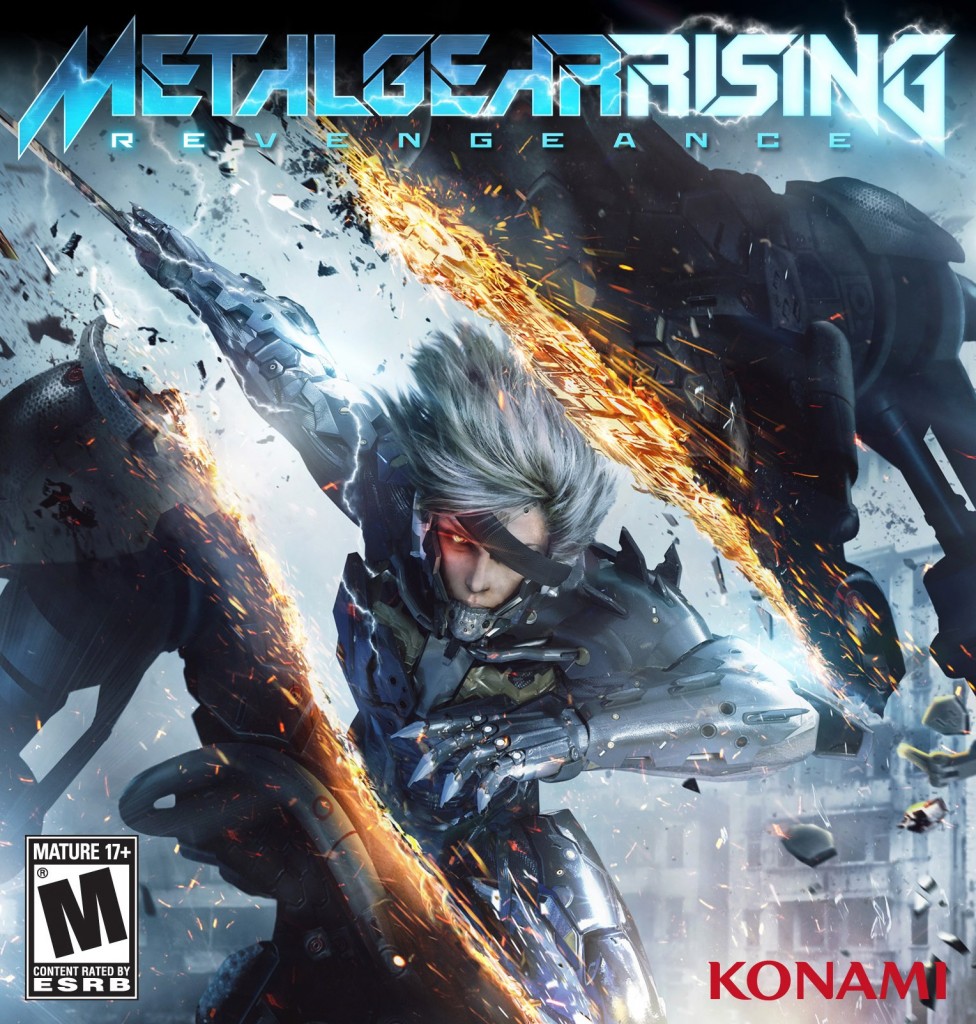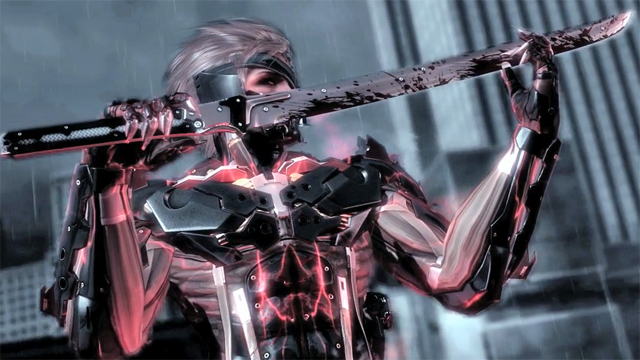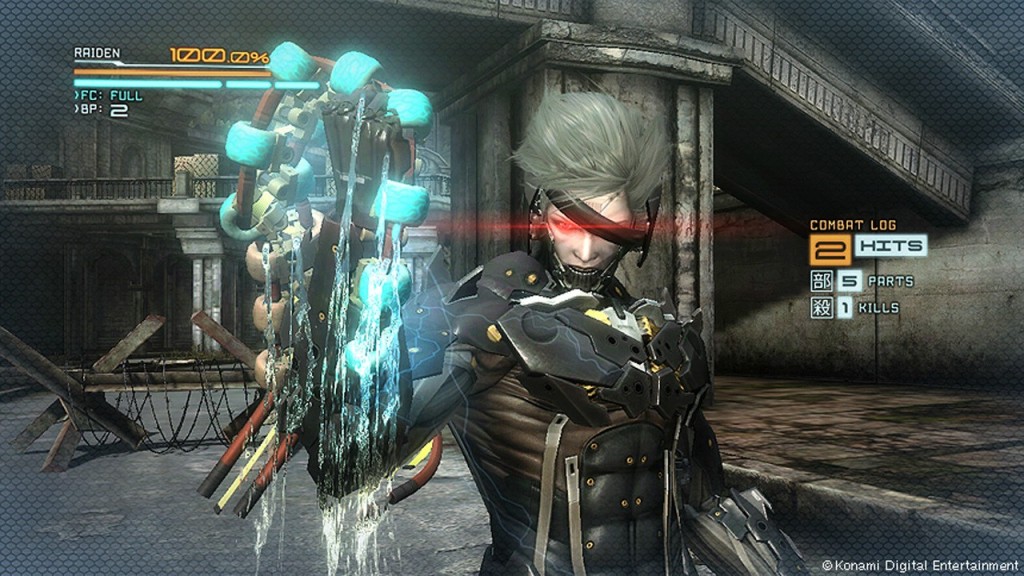The Metal Gear video game franchise has a reputation for excellence in storytelling and innovative gameplay. It is also comically difficult. Join Deadshirt Editor-in-Chief and absolutely terrible video gamer Dylan Roth as he plays through the entire Metal Gear canon in celebration of the long-awaited Metal Gear Solid V: The Phantom Pain, released earlier this month.
The Metal Gear franchise separates itself from a lot of the action-adventure pack by emphasizing patience and stealth over run-and-gun carnage, with later installments even rewarding players for completing missions without killing anyone, or even being seen. And then there’s Metal Gear Rising: Revengeance, a game which is…the opposite of that. A complete departure from the Metal Gear Solid series, Revengeance is a super fast, super loud hack-and-slash action game centered on nigh-unkillable cyborg ninja Raiden on a quest so furious that they had to make up a new word to describe it.
Raiden is introduced as the lead playable character of Metal Gear Solid 2: Sons of Liberty, a young and fairly naive government agent with a shadowy past who discovers that he’s being manipulated by the shadowy Patriots. When he next appears in Metal Gear Solid 4: Guns of the Patriots, Raiden has become a superpowered cyborg ninja capable of taking down giant robots with only a katana. Raiden’s balletic swordfighting style made for some amazingly cool cutscene material, but the character wasn’t playable in MGS4, so Hideo Kojima and company envisioned a game that would allow players to perform these amazing feats for themselves.
Metal Gear Solid: Rising, as it was originally to be called, would have taken place between Sons of Liberty and Guns of the Patriots, and told the story of how Raiden came to become the unstoppable killing machine seen in the latter story. However, when Kojima Productions struggled with creating the game, it subcontracted the work to PlatinumGames, who altered the story to set it in 2016, making it a sequel to Guns of the Patriots rather than a prequel. This allowed them to establish a new status quo following the end of the Solid Snake cycle, and to make alterations to Raiden’s design and abilities without creating continuity errors.
The result is a product that feels very little like a Metal Gear Solid game but retains enough of the look and the themes of the original that it couldn’t be mistaken for anything else. It’s neither written nor directed by Hideo Kojima, but it is still considered canon in the Metal Gear continuity. (Of course, the same was initially said of Portable Ops, which has since been demoted to apocrypha.) It’s one of the most widely available Metal Gear titles, released on PlayStation 3, XBox 360, Mac, PC, and even Shield Portable, but also one of the most poorly received, with plans for a sequel quietly being shelved.
But for me, having just torn through the seven previous Metal Gear titles in rapid succession, Revengeance made for a fun and refreshing palate cleanser, a welcome deep breath of insanity before plunging into the depths of Metal Gear Solid V.
Story
Metal Gear Rising: Revengeance has without a doubt the most ridiculous story in all of the existing Metal Gear canon. A few short years after the fall of the Patriots, private military companies continue to dominate Earth’s wars thanks to their use of cybernetically enhanced soldiers. Raiden, who’s more machine now than man, works for the PMC Maverick, protecting politicians and other VIPs. When one of his protectees is killed by a rival company, Raiden uncovers a sick plot to harvest the brains and body parts of street children from around the world. Raiden pledges not only to stop this scheme, but also to collect the stolen child brains so they can be given cyborg bodies and a new lease on life.
Raiden’s rampage sees him cutting his way through advanced cyborg mercenaries til he gets to the man at the top: an evil, superpowered United States Senator.
The story of Revengeance is short and stupid by Metal Gear standards, punctuated by brief moments of depth and clarity that are forgotten the moment they become inconvenient. I’ll give you an example of what I mean:
Not long into the main campaign, Raiden has just easily hacked apart a wave of nameless, faceless cyborg soldiers when he’s confronted by his new arch-nemesis: a highly skilled cyborg samurai called Jetstream Sam. Sam chastises Raiden for the mercilessness of his attacks, the way he doesn’t see his victims as human beings. Raiden operates under the belief that anyone working for an evil PMC has made their choice, and having become instruments of evil, they no longer deserve to live. Sam challenges that belief, offering Raiden to hear the thoughts of the next wave of cyborgs—his next victims.
What Raiden hears isn’t what he expects: desperation. The mercenaries he’s been so thoughtlessly massacring chose the soldier’s life reluctantly, as a means to help their families or escape a war-torn homeland, or just to keep themselves fed. They’re victims of circumstance, like Raiden himself. When the cinematic ends, Raiden is weak and confused, surrounded by enemy troops whose thoughts are still ringing in his head. The player takes control of Raiden as he slashes through the soldiers, silencing them one by one. There is no non-lethal option; you can’t move on until each and every one of them is dead.
This sends Raiden into a rage, awakening a side of his personality that he calls “Jack the Ripper,” long suppressed since his days as a child soldier in Liberia. Raiden admits to himself that a part of him actually enjoys killing, and that he’s a monster for the things he’s done. From this point on, Raiden/the player resumes slaying hundreds of cyborgs without remorse or regret, as if this scene never happened. The player has to forget about it too, because completing the game requires that you kill just about everyone you see. The sequence represents a brief flash of metafictional brilliance, pointedly reminding the player how fucked up they are for enjoying the game’s violence, before immediately forgiving you and encouraging you to fight on, because it’s just a game, y’know.
Revengeance has some other areas where it attempts to be high-minded: it’s highly critical of American foreign policy and exceptionalism, suggesting that nations as institutions are strongest when their individual citizens have low self-worth, and that nations like to keep it that way. If someone has nothing of their own to be proud of, they’ll take solace in national pride, believing that their heritage is what makes them special, and if that’s the case, then anything they do in the name of their country becomes justified. America’s hair-trigger war reflex is on full display here, as a corrupt senator attempts to provoke a war with Pakistan.
On the whole, however, the story is just an engine to keep the gameplay moving, which may be par for the course in action games, but is disappointing for the usually plot-first Metal Gear franchise.
Gameplay
Metal Gear Rising: Revengeance is a game designed to make the player feel like an unstoppable ninja death machine, and it does a pretty fair job at that. Where the Metal Gear Solid series is built around sneaking, hiding, and shooting, Revengeance is all about running, cutting, and more running. There are points in the game where sneaking is necessary (and yes, you can hide in a cardboard box, as this is still Metal Gear), but Raiden is so damn powerful that it’s usually easier just to dive into the fray and hack your foes to pieces.
Secondary weapons like grenades and rocket launchers are available in Revengeance, but most of the combat is done using Raiden’s high-frequency katana, or one of the cool melee weapons recovered from the bosses you defeat. Much of the combat involves button-mashing and performing simple combos using the light and heavy attack buttons, but Revengeance features a cool signature mechanic in the form of Blade Mode, in which you can manually take control of the angle and direction you’re cutting, allowing the player to selectively remove limbs off of their opponents. The game keeps track of how many pieces you cut people and objects into, and that number can reach into the high hundreds.
One of the most fun applications of Blade Mode is the zandatsu technique, which I believe translates to “cut your enemies in half, reach into their bodies and yank out their spines to absorb their sweet sweet fluids.” That’s right, Raiden is powered in part by cyborg vampirism, recovering health and energy by stealing power from downed opponents. Mastering zandatsu is essential to surviving long missions and boss battles, but is also great fun, accompanied by a variety of slick acrobatic animations. Going into Blade Mode while charged up lets you slice in slow motion, showing off the game’s 60fps frame rate and making possible some impressive combos.
The biggest weakness in Revengeance‘s gameplay is redundancy. Raiden possesses most of his main abilities as early as the second stage, and the unlockable combos don’t add much variety. Three of the bosses drop unique weapons that can be incorporated into your play, but they each contribute relatively few moves. Each stage plays essentially the same, running through an area, being confronted by waves of enemies, slicing them up, and then taking on a boss who must be defeated in basically the same way as their goons. Revengeance often feels like an arcade game, a simple, quick to learn experience that simply gets incrementally more difficult without really changing at all.
When I first started playing, I couldn’t stop laughing at the absurd power trip of being Raiden, but after the initial thrill wore off, I found myself frustrated by the game’s repetition and shortcomings. The fact that defeating later bosses hinges on unlocking better cyborg bodies in VR mission minigames didn’t help matters; having to replay the same stage twenty times hoping to shave a few seconds off your score is few players’ idea of a good time.
Still, to their credit, PlatinumGames succeeded in creating a new kind of Metal Gear game without completely throwing out the baby with the bathwater, and if they were to create a sequel, I would probably shell out sixty bucks to play it.
And so ends the retrospective portion of SNAAAAAAAKE! With no more games standing in my way, I’m ready to begin Metal Gear Solid V, first the prologue chapter Ground Zeroes and then the main course, The Phantom Pain. You may not hear from me for a while, as the game is pretty damn long, but I promise to return to chronicle my experience, analyze the story, and break down its gameplay. Thanks for reading, I’ll see you in Outer Heaven.







